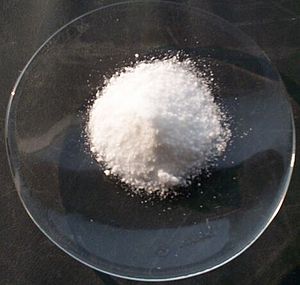Difference between revisions of "Potassium chloride"
m (→Projects) |
|||
| Line 22: | Line 22: | ||
*Make [[potassium chlorate]] | *Make [[potassium chlorate]] | ||
*Make colored flames | *Make colored flames | ||
| + | *Growing crystals | ||
==Handling== | ==Handling== | ||
Revision as of 12:50, 3 February 2016
Potassium chloride is a salt with the formula KCl. It is a white crystalline solid. It is edible, commonly used as a salt substitute, but it has a sharp, biting aftertaste (which is often described as metallic) that many people find unpleasant.
Contents
Properties
Physical
Potassium chloride is a white crystalline solid with a cubic structure. It has a molar mass of 74.55. Its solubility in water is 28g/100mL at 0˚C and 56.7g/mL at 100˚C[1]
Chemical
Potassium chloride can be used as a source of chloride ions in reactions, although sodium chloride is more common. KCl is often used to make KClO3 (potassium chlorate) using electrolysis. The high solubility of KCl at low temperature compared to KClO3 makes it easy to separate the two compounds from a solution.
Availability
Potassium chloride can be easily obtained in relatively pure form at the grocery store as a salt substitute for people with low-sodium diets. This source is mixed in with potassium bitartarate to improve taste. However, salt substitute is deliberately overpriced by the companies that make it; it is many times cheaper to obtain potassium chloride through other means, often through larger industrial quantities, which are usually purer anyway. This includes buying potassium chloride as fertilizer, sometimes referred to as muriate of potash. In some hardware stores, sodium-free water purification tablets made of 99% or higher potassium chloride can be purchased, usually in bags weighing about 40 lbs. These are by far the most economic method of purchasing potassium chloride.
Preparation
Potassium chloride can be prepared from potassium hydroxide and hydrochloric acid, but this method is impractical in the lab due to the fact that KCl is usually easier to get than potassium hydroxide. Potassium carbonate or potassium bicarbonate can also be added to hydrochloric acid, but this requires care to control carbon dioxide outgassing.
Projects
- Make potassium chlorate
- Make colored flames
- Growing crystals
Handling
Safety
No safety measures are needed with potassium chloride. It is non-toxic unless directly consumed in very large quantities.
Storage
Potassium chloride should be stored in closed bottles. No special storage is required.
Disposal
Potassium chloride can be poured down the drain.
References
- ↑ CRC Handbook of Chemistry and Physics 66th edition

